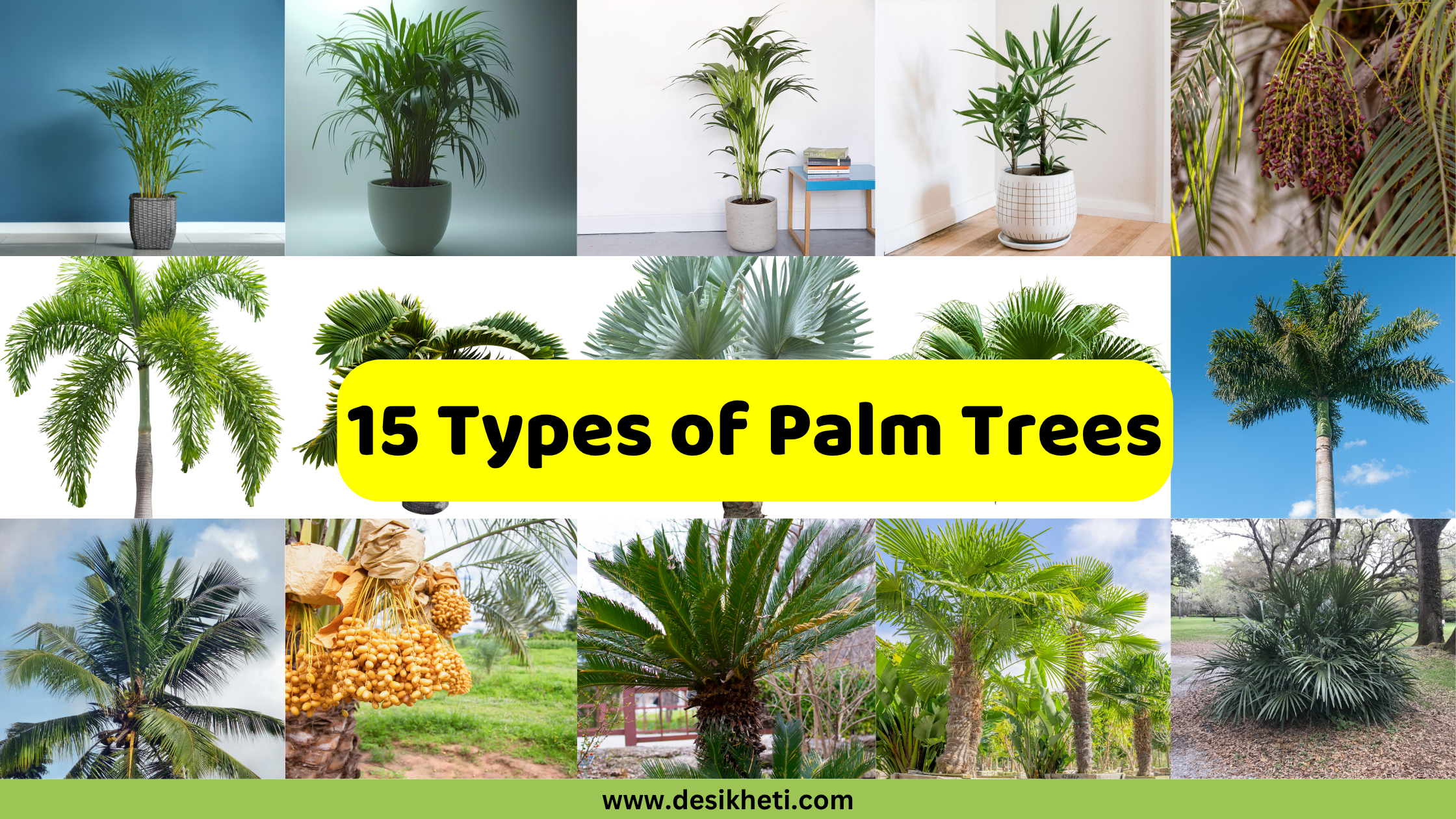Table of Contents
Introduction
Palm trees are more than just iconic symbols of tropical landscapes; they represent a diverse group of plants with a wide range of uses, from ornamental beauty to commercial value. Whether you’re looking to enhance your indoor space with elegant varieties like the Areca or Parlor Palm, beautify your outdoor garden with majestic options like the Foxtail or Bismarck Palm, or cultivate Coconut and Date Palms, these trees offer unmatched versatility.
In this blog, we’ll explore 15 popular indoor, outdoor ornamental, and commercial palm trees, highlighting their botanical features, ideal growing conditions, and practical benefits.
Indoor Palm Trees
Areca Palm

Botanical Name: Dypsis lutescens
Also known as the Butterfly Palm or Golden Cane Palm, the Areca Palm is a popular ornamental plant in India. It features multiple smooth, yellow-green canes resembling bamboo, with lush, feathery fronds composed of 40–60 leaflets.
Indoors, it typically grows 6 to 10 feet tall, adding a tropical charm to homes and offices. It prefers bright, indirect sunlight and partial shade outdoors, thriving best in well-draining, loamy soil rich in organic matter.
Uses and Benefits:
- Acts as a natural air purifier, improving indoor air quality
- Adds a tropical aesthetic to both interior and exterior spaces
- Helps increase humidity, beneficial in dry indoor environments
- Low maintenance and adaptable to indoor conditions
Parlor Palm

Botanical Name: Chamaedorea elegans
The Parlor Palm is a compact, slow-growing palm native to Mexico and Guatemala, ideal for small indoor spaces. It features thin green stems and delicate, deep green, arching fronds that are soft to the touch. It usually grows 3 to 6 feet tall indoors and thrives in low to moderate indirect light.
This palm prefers well-draining, peat-rich potting soil. It enjoys average to high humidity but adapts well to typical indoor conditions.
Uses and Benefits:
- Ideal for small spaces, desks, shelves, and corners
- Adds a lush, tropical feel to rooms with minimal light needs
- Easy to maintain with minimal watering requirements
Kentia Palm
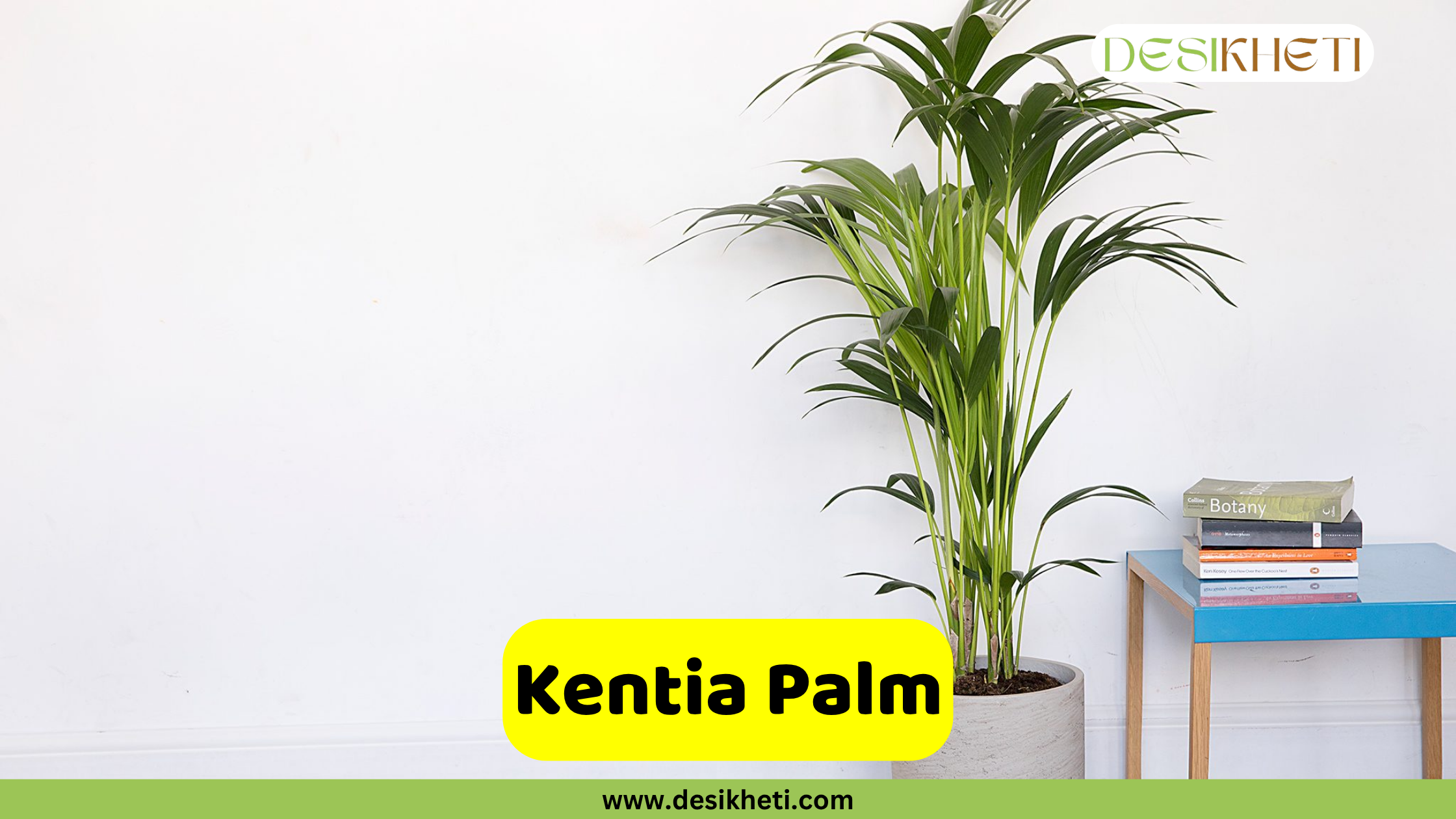
Botanical Name: Howea forsteriana
The Kentia Palm is an elegant, slow-growing palm native to Lord Howe Island, Australia. It has long, arching dark green fronds that spread gracefully from slender, upright stems.
Indoors, it reaches 6 to 10 feet in height and is highly adaptable to various light conditions. It thrives best in bright, indirect light but also tolerates lower light levels. This palm prefers well-aerated, free-draining soil and complements luxury interiors and corporate spaces due to its refined appearance.
Uses and Benefits:
- Perfect for adding sophistication to homes, offices, and hotels
- Tolerates low light, making it suitable for indoor settings
- Low maintenance with infrequent repotting needs
Lady Palm
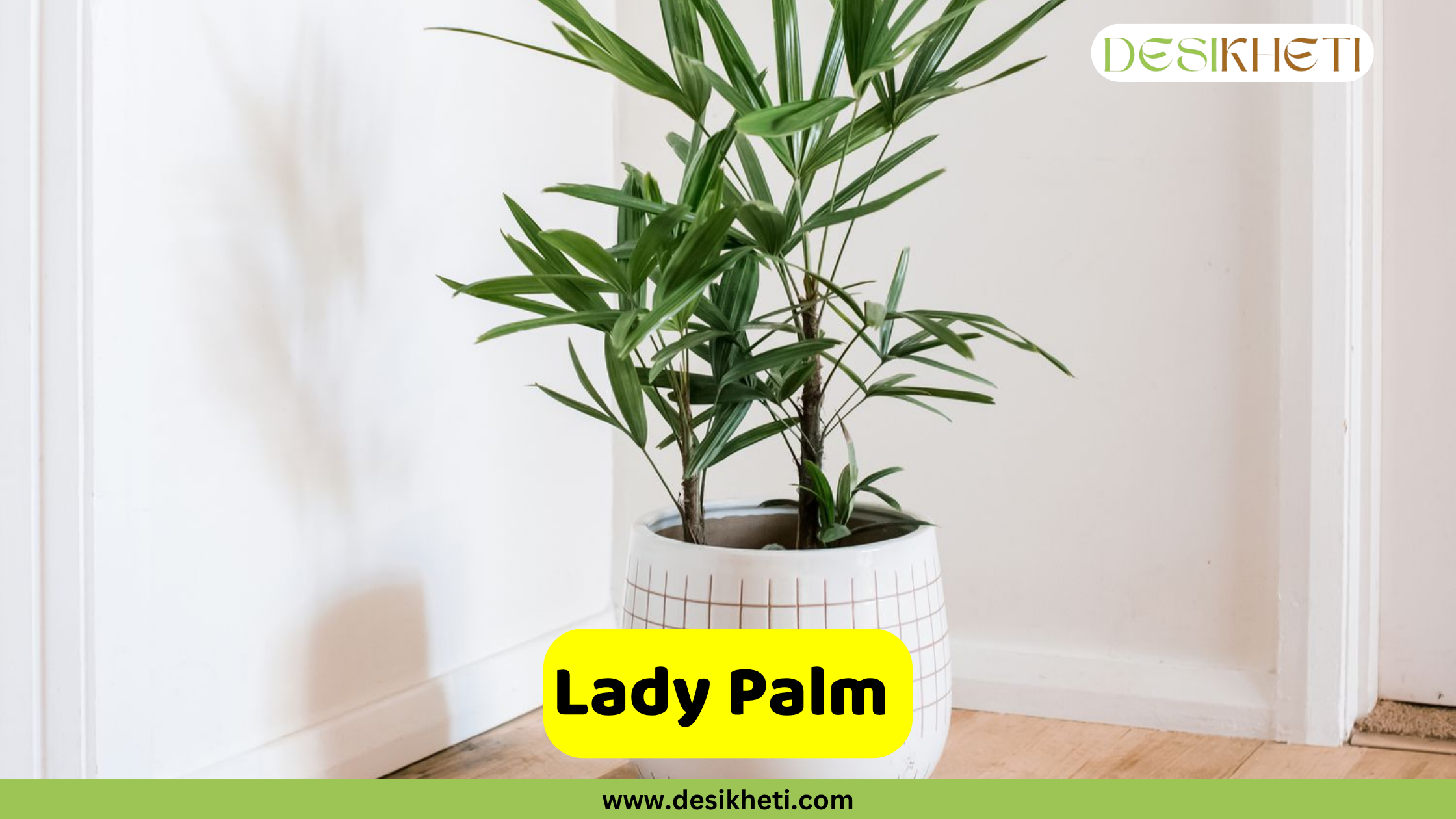
Botanical Name: Rhapis excelsa
Native to Asia, the Lady Palm is a graceful species with multiple slender, bamboo-like canes and dark green, fan-shaped leaves divided into broad, glossy segments. It grows 4 to 6 feet tall indoors and up to 10–12 feet outdoors.
It prefers low to medium indirect light and moderate to high humidity but also adapts well to dry indoor air. This palm grows best in rich, well-draining potting soil.
Uses and Benefits:
- Excellent for shaded indoor areas and office spaces
- Known for its air-purifying abilities
- Adds an elegant, structured look to interiors and verandahs
Pygmy Date Palm
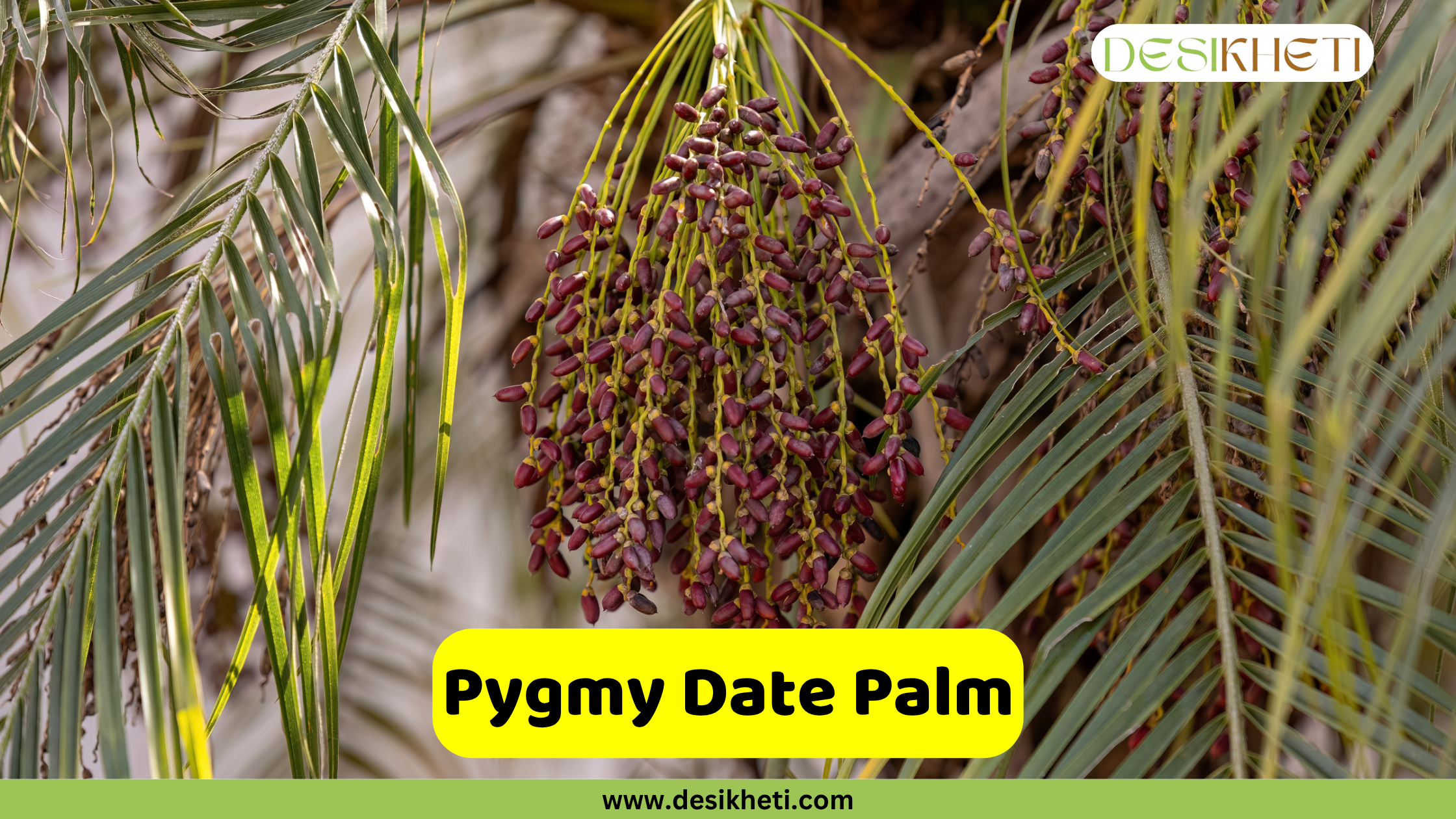
Botanical Name: Phoenix roebelenii
The Pygmy Date Palm is a small, elegant palm from Southeast Asia, known for its feathery, arching fronds and a slender trunk marked by old leaf bases. It grows 4 to 6 feet tall indoors and up to 10–12 feet outdoors, making it ideal for small gardens, balconies, and patios.
It thrives in bright indirect light to partial sun and prefers warm temperatures between 20°C and 35°C. It grows well in well-draining sandy or loamy soil and adapts easily to average indoor humidity.
Uses and Benefits:
- A great focal point for indoor and outdoor landscapes
- Enhances small spaces and patios with tropical appeal
- Compact size is ideal for container gardening
Sago Palm
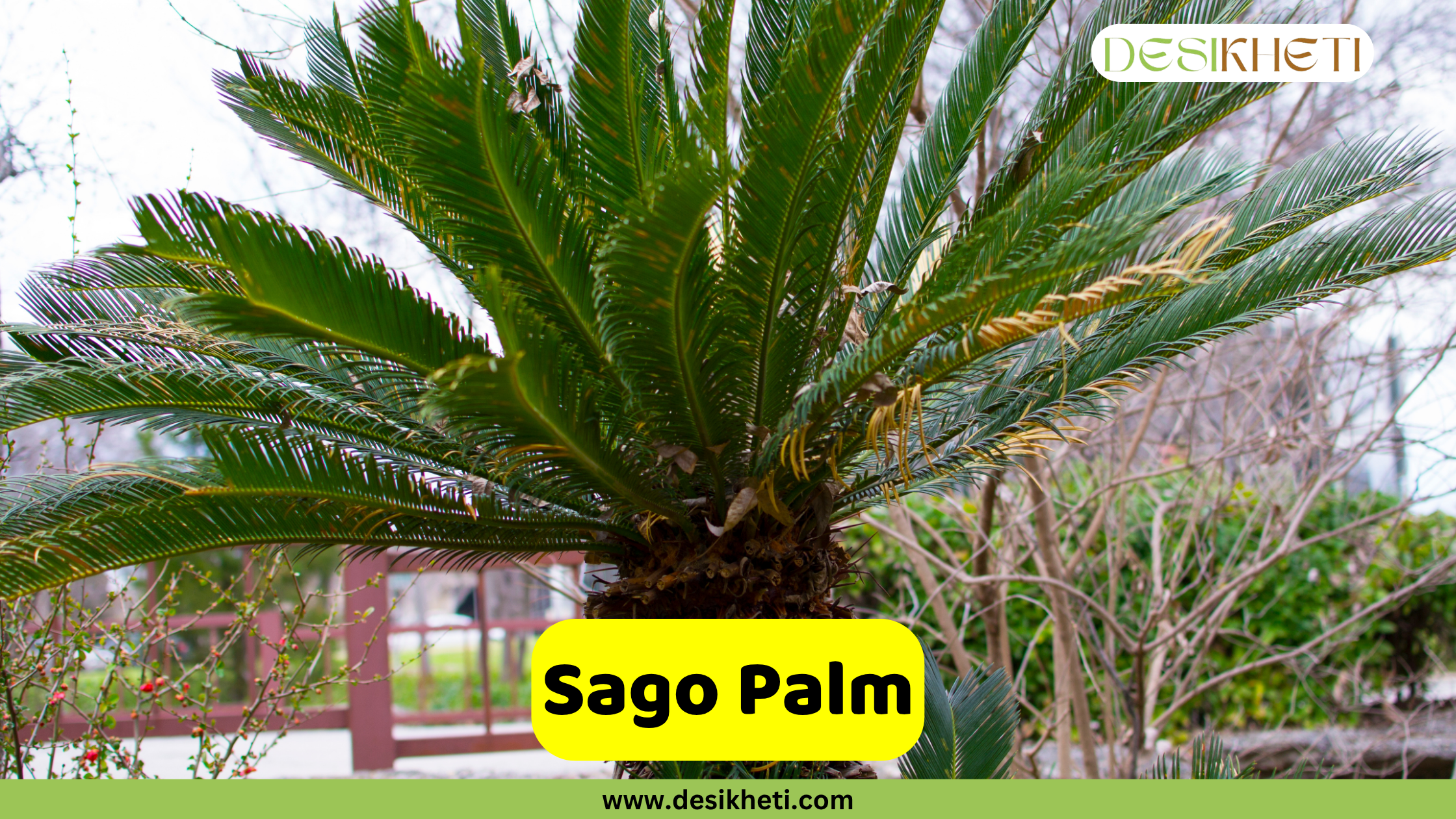
Botanical Name: Cycas revoluta
Although not a true palm but a cycad, the Sago Palm is known for its stiff, dark green, feather-like fronds that radiate symmetrically from a thick, rugged trunk. It grows slowly to a height of 3–6 feet and prefers bright indirect light to partial shade. This plant requires well-draining sandy or loamy soil and adapts well to moderate humidity and typical indoor conditions.
Uses and Benefits:
- Popular ornamental plant for indoor and outdoor decoration
- Leaves are used in floral arrangements and landscaping
- Cultivated for educational and botanical collections
- Low maintenance and drought-tolerant once established
Caution: The Sago Palm is toxic to pets and humans if ingested.
Outdoor Ornamental Palm Trees
Foxtail Palm

Botanical Name: Wodyetia bifurcata
The Foxtail Palm is a striking ornamental species native to Queensland, Australia, known for its bushy, plume-like fronds that resemble a fox’s tail. Its smooth trunk and symmetrical crown give it a clean, tidy appearance, making it a favorite for avenues, resorts, parks, and home gardens.
It typically grows 10–12 feet tall in gardens and can reach 20–30 feet under ideal outdoor conditions. It thrives in full sun to partial shade and prefers bright, direct light for optimal growth.
Uses and Benefits:
- An ideal choice for landscape avenues and large garden spaces
- Low maintenance and adapts well to various outdoor settings
Bottle Palm
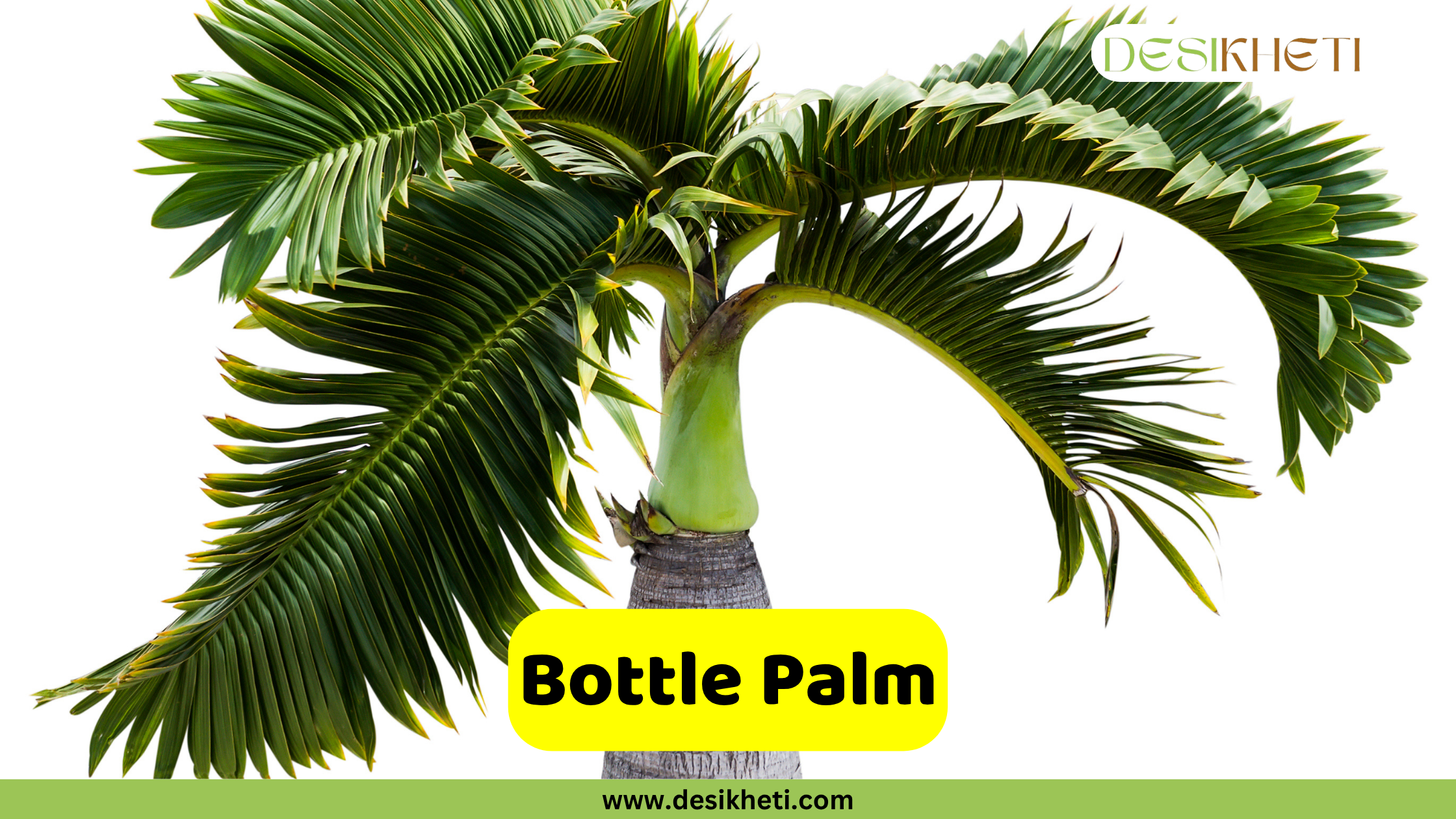
Botanical Name: Hyophorbe lagenicaulis
The Bottle Palm is a distinctive ornamental palm native to Mauritius, named for its swollen, bottle-shaped trunk most prominent in young plants. This trunk stores water, helping the palm endure dry conditions. It typically bears 4 to 6 arching, feather-like fronds, giving it a minimalist yet elegant tropical appearance.
It grows slowly and reaches about 6 to 10 feet in height, making it ideal for small gardens, patios, entrances, and container planting. It prefers full sun but adapts to partial shade and thrives in warm, frost-free climates.
Uses and Benefits:
- Excellent ornamental choice for compact spaces and tropical-themed garden
- Eye-catching trunk structure adds architectural interest to landscapes
Bismarck Palm
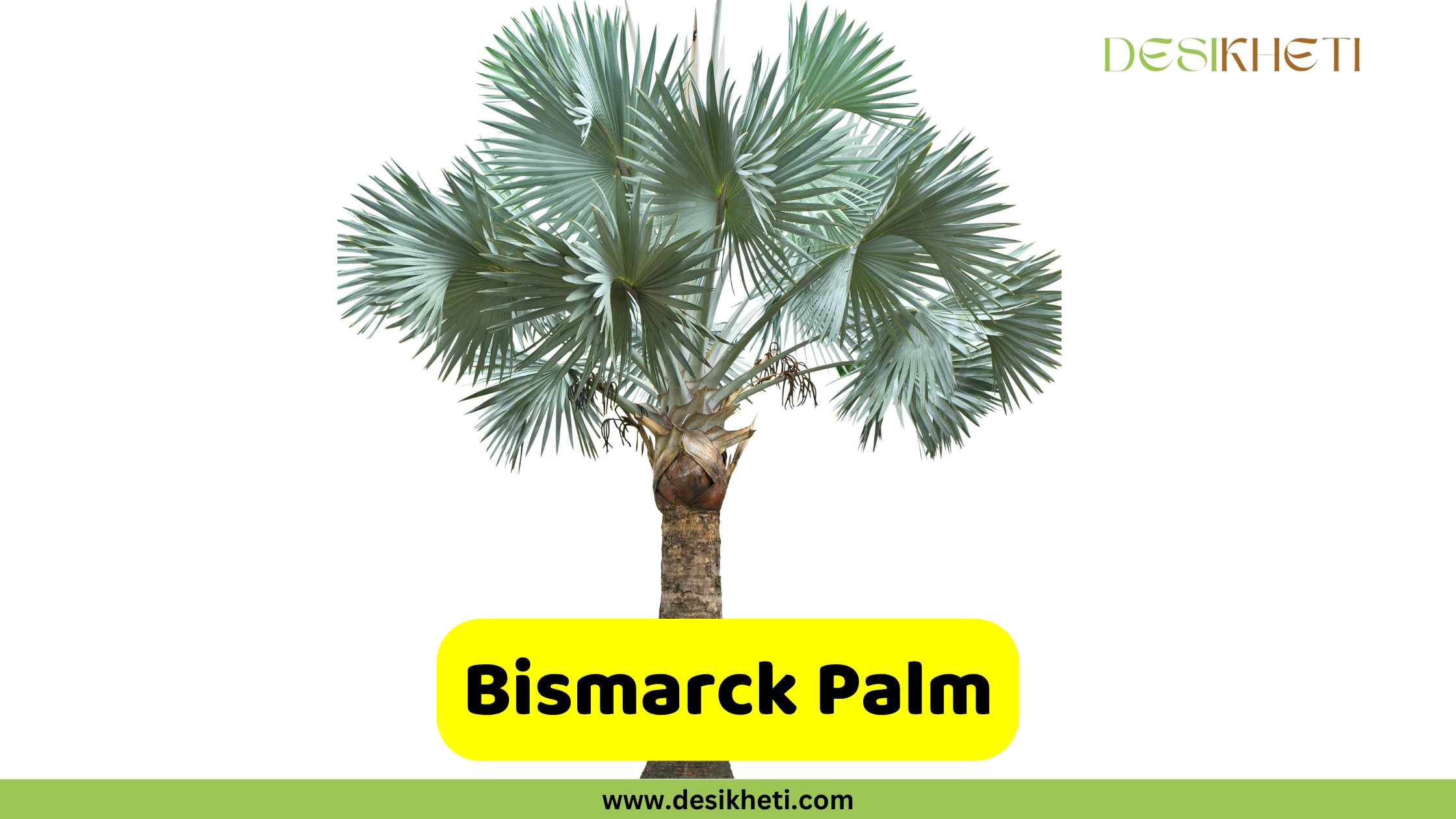
Botanical Name: Bismarckia nobilis
The Bismarck Palm is a majestic and dramatic palm native to Madagascar, admired for its massive, silvery-blue, fan-shaped leaves that can span up to 10 feet. Its thick gray trunk supports a broad, symmetrical crown, making it a bold focal point in any landscape.
It grows up to 30–40 feet tall in outdoor settings and thrives in full sun and warm temperatures. Due to its impressive size and beauty, it is best suited for large gardens, open lawns, and parks.
Uses and Benefits:
- A dramatic centerpiece for large landscapes and avenue plantings
- Unique silver foliage adds color contrast and tropical flair
- Drought-tolerant and low-maintenance once fully established
Chinese Fan Palm
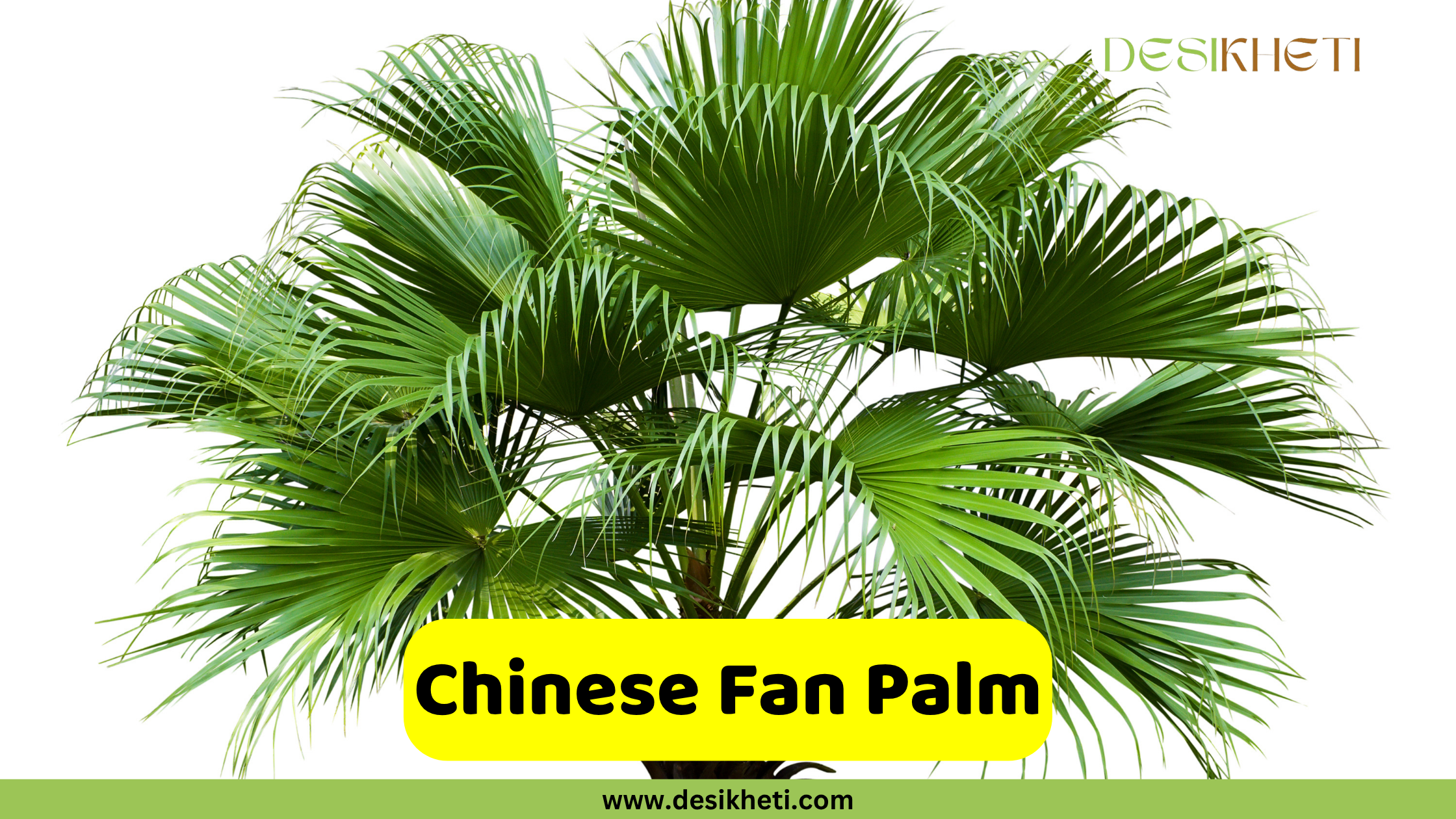
Botanical Name: Livistona chinensis
The Chinese Fan Palm is known for its large, circular, fan-shaped leaves with a glossy green finish. The deeply divided leaf segments and prominent veins give it a striking texture, while its slender, ringed trunk supports an open, rounded crown. It typically grows 20–30 feet tall outdoors and is a popular choice for gardens, courtyards, and streetscapes.
Uses and Benefits:
- Ideal for urban landscaping, streetscapes, and spacious gardens
- Adds architectural beauty with its unique fan-like foliage
- Low-maintenance and tolerant of varied growing conditions
Royal Palm
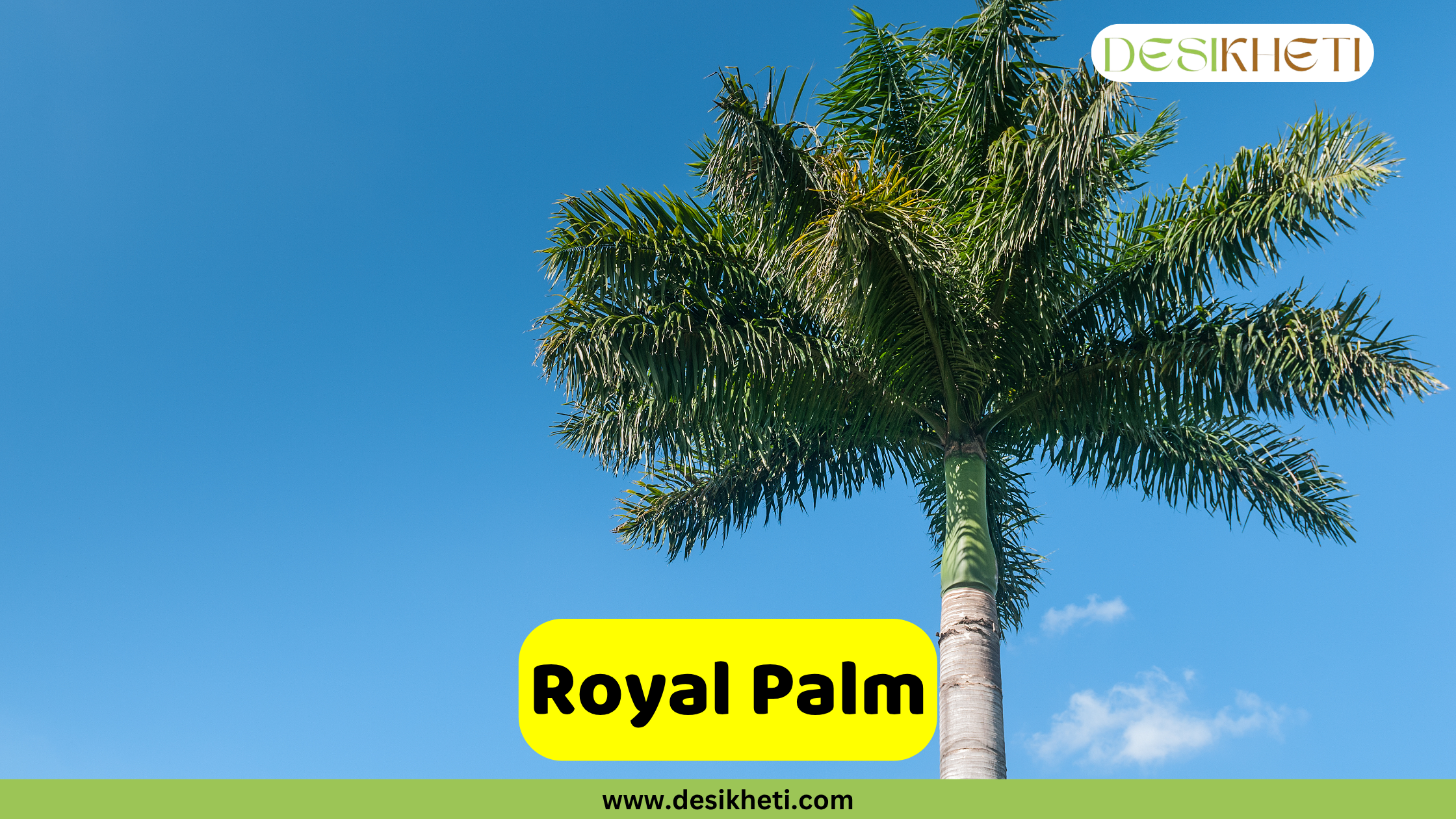
Botanical Name: Roystonea regia
The Royal Palm features a tall, smooth, light gray trunk topped with a graceful crown of arching, feather-like fronds. A distinctive green crownshaft just below the leaves enhances its stately appearance.
Reaching heights of 50–70 feet outdoors, this palm is ideal for parks, large gardens, and avenue plantings. It thrives in full sun and prefers warm, tropical to subtropical climates.
Uses and Benefits:
- A stunning vertical accent for large landscapes and public spaces
- Fast-growing and low-maintenance once established
Commercial / Functional Palm Trees
Coconut Palm
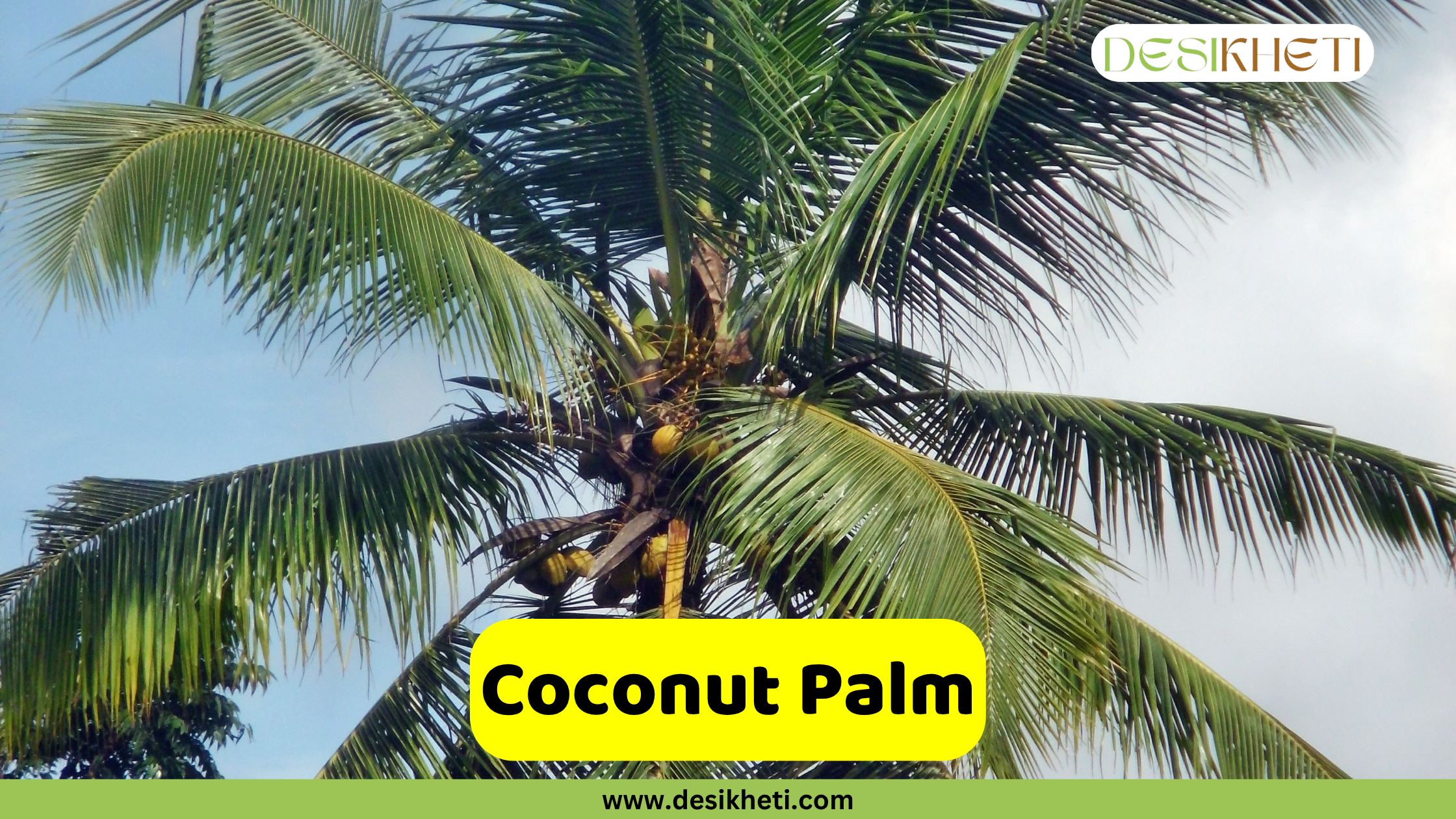
Botanical Name: Cocos nucifera
The Coconut Palm is a tall, iconic tropical species with a slender, smooth trunk and large, arching, feather-like fronds. It thrives in coastal and tropical regions, growing up to 50–100 feet tall depending on the variety. This palm requires full sun and prefers warm, humid climates. It grows best in well-draining sandy soils.
Uses and Benefits:
- Produces coconuts used for food, oil, water, and cosmetics
- Provides raw materials for coir fiber, mats, and brushes
- Palm leaves are used for thatching and weaving
- Supports coastal ecosystems by preventing soil erosion
Date Palm

Botanical Name: Phoenix dactylifera
The Date Palm is a medium to tall palm well known for producing edible sweet dates. It features a thick, rough trunk often with persistent leaf bases and large pinnate fronds forming a dense crown.
This palm prefers full sun and hot, dry climates (25°C to 45°C), growing best in well-draining sandy or loamy soils. It is drought-tolerant but performs best with moderate watering.
Uses and Benefits:
- Produces nutritious, sweet dates rich in fiber and minerals
- Dates are consumed fresh, dried, or in various culinary preparations
- Leaves are used for basketry and roofing materials
- Widely cultivated for ornamental landscaping in arid regions
Palms Suitable for Temperate Regions
Windmill Palm
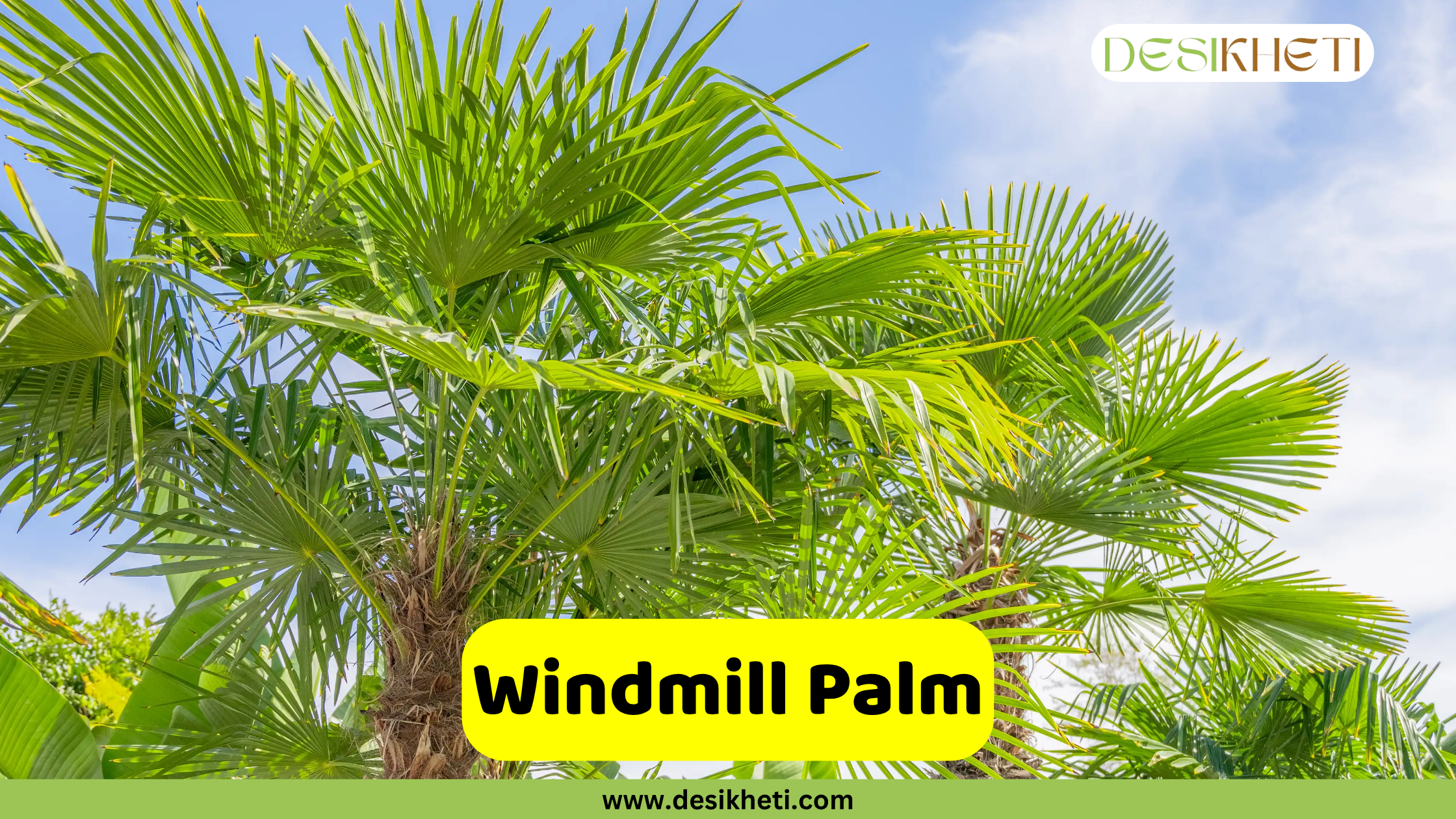
Botanical Name: Trachycarpus fortunei
The Windmill Palm is a hardy, slow-growing species with fan-shaped dark green leaves and a fibrous, hairy trunk. Well-suited for cooler climates, it grows 10–30 feet tall and prefers partial shade to full sun.
It thrives in well-draining, slightly acidic to neutral soil and adapts to both dry and moderately humid environments.
Uses and Benefits:
- Suitable for ornamental planting in temperate gardens
- Commonly used as a cold-hardy palm in non-tropical landscapes
- Leaves are occasionally used for thatching and crafts
- Can be grown in containers for patios or balconies
Needle Palm

Botanical Name: Rhapidophyllum hystrix
The Needle Palm is a short, clumping shrub with glossy, fan-shaped green leaves and sharp, needle-like spines at the base. It is one of the most cold-hardy palms, capable of surviving extreme temperatures below -20°C.
It grows 3–6 feet tall and wide, preferring partial to full shade and moist, well-draining, acidic soil rich in organic matter. Its dense growth makes it ideal for hedges or shaded ground cover.
Uses and Benefits:
- Ideal for cold-climate gardens as a hardy ornamental palm
- Serves as a low hedge or natural border in landscaping
- Provides shelter for wildlife in garden ecosystems
- Low pest susceptibility reduces maintenance requirements
Other Palm Tree Names (Non-Repeated)
Here are additional palm species you might consider including or researching further:
- Bamboo Palm (Chamaedorea seifrizii)
- Queen Palm (Syagrus romanzoffiana)
- Majesty Palm (Ravenea rivularis)
- Mediterranean Fan Palm (Chamaerops humilis)
- Dwarf Palmetto (Sabal minor)
- Silver Palm (Coccothrinax argentata)
- Petticoat Palm (Copernicia macroglossa)
- Nipa Palm (Nypa fruticans)
- California Fan Palm (Washingtonia filifera)
- Mexican Fan Palm (Washingtonia robusta)
- Senegal Date Palm (Phoenix reclinata)
- Caranday Palm (Trithrinax campestris)
- Sabal Palm (Sabal palmetto)
Growing and Care Tips for Palm Trees
Choose the Right Palm for Your Climate: Palms thrive best when matched with the appropriate temperature and humidity conditions. Tropical palms need warm, humid climates, while hardy palms can tolerate cooler temperatures.
Sunlight Needs: Most palms prefer full sun or partial shade. Be sure to check the light requirements of your specific palm species to ensure healthy growth.
Soil and Drainage: Well-draining soil is essential to prevent root rot. Sandy or loamy soils enriched with organic matter work well for most palm varieties.
Watering: Water regularly during the growing season, but avoid waterlogging. While established palms can tolerate some drought, young palms require consistent moisture.
Fertilization: Use a palm-specific or balanced slow-release fertilizer 2–4 times per year to promote vibrant foliage and strong growth.
Pruning: Remove only dead, yellowing, or damaged fronds to maintain the palm’s appearance and health. Avoid over-pruning, as palms rely on their fronds for photosynthesis and energy.
Pest Monitoring: Watch for common pests such as scale insects, spider mites, and palm weevils. Early detection and treatment are key to keeping palms healthy.
Repotting & Space: For potted palms, report every few years when they become root-bound. Outdoor palms should be given ample space to accommodate their mature size.
From the gentle fronds of indoor favorites to the towering elegance of outdoor ornamental and commercial palms, these plants offer much more than just greenery. They enhance our homes and landscapes by improving air quality, providing shade, producing valuable fruits, and adding tropical charm.
Understanding their specific growing needs and benefits can help you select the right palms for your space whether it’s a cozy indoor corner or a sprawling garden. Start planting today and enjoy the lush elegance and practical benefits that palms bring to every setting!
FAQs on Palm Trees
1. What is special about the Areca Palm?
A. The Areca Palm is a popular indoor plant known for its feathery fronds, air-purifying qualities, and ability to add tropical appeal to any space.
2. What is another name for a Parlor Palm?
A. The Parlor Palm is also known as Chamaedorea elegans.
3. What are some fun facts about Lady Palms?
A. Lady Palms are slow-growing, can tolerate low light, and are often used in ornamental landscaping and interiors for their fan-shaped leaves.
4. What are the benefits of the Lady Palm?
A. Lady Palms improve indoor air quality, are non-toxic to pets, and thrive in indoor environments with minimal care.
5. How fast do Pygmy Date Palms grow?
A. Pygmy Date Palms grow slowly, adding about 3 to 4 inches in height per year under optimal conditions.
6. What are the benefits of the Pygmy Date Palm?
A. Pygmy Date Palms are compact, ornamental, drought-tolerant, and ideal for small gardens or containers.
7. What are some fun facts about Foxtail Palms?
A. Foxtail Palms get their name from their bushy fronds that resemble a fox’s tail and are native to Australia.
8. What are the benefits of Foxtail Palms?
A. Foxtail Palms are low-maintenance, visually striking, and suitable for tropical and subtropical landscapes.
9. What is another name for a Bottle Palm?
A. The Bottle Palm is also known as Hyophorbe lagenicaulis.
10. What is the lifespan of a Bismarck Palm tree?
A. Bismarck Palm trees can live for 50 to 100 years with proper care and a suitable climate.
11. What is another name for the Bismarck Palm?
A. The Bismarck Palm is also called Bismarckia nobilis.
12. What is the Chinese Fan Palm used for?
A. Chinese Fan Palms are used in landscaping, as potted ornamental plants, and sometimes for making hand fans or other handicrafts.
13. What are the benefits of Royal Palms?
A. Royal Palms are elegant, provide shade, require low maintenance, and are widely used for avenue and garden decoration.
14. What is another name for a Coconut Palm?
A. The Coconut Palm is also known as Cocos nucifera.
15. What are the benefits of Coconut Palm trees?
A. Coconut Palms provide coconuts for food and oil, leaves for thatching, wood for construction, and coir for making ropes and mats.
16. What are the four main uses of the Date Palm tree?
A. Date Palm trees are used for producing dates, providing shade, supplying leaves for handicrafts, and wood for fuel or construction.
